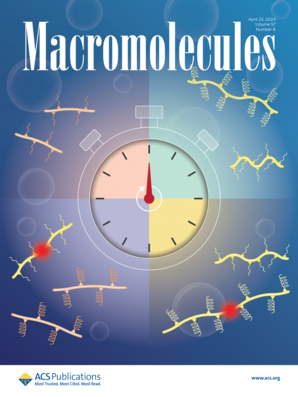Machine-Learning-Assisted Design of Mechanically Robust Room-Temperature Self-Healing Epoxy Resins
IF 5.1
1区 化学
Q1 POLYMER SCIENCE
引用次数: 0
Abstract
Epoxy resins are the most widely used thermosets, yet they typically lack the capability to self-heal at room temperature due to their molecular chains and networks being immobilized in a glassy state. Herein, machine learning identifies fractional free volume as a crucial factor for enabling self-healing in the glassy state. Guided by this insight, we designed an epoxy network incorporating dangling chains together with numerous hydrogen bonds and aromatic disulfide bonds. The dangling chains introduce large free volume, facilitating the reorganization of hydrogen bonds and the radical-mediated exchange of aromatic disulfide bonds, thereby imparting prominent self-healing capability at room temperature. Notably, the damaged epoxy not only can recover 81.2% of its tensile strength without intervention but also can autonomously and completely eliminate electrical tree damage and scratches at room temperature. Under mild compression, 100% healing occurs within tens of minutes in the glassy state. Additionally, the optimized epoxy exhibits high physicomechanical properties with a tensile strength of 42.1 MPa, a modulus of 2.9 GPa, and a glass transition temperature of 53.2 °C. Its ability to self-heal both electrical tree and mechanical damage at room temperature positions this epoxy as a promising material for advanced insulating and sealing applications.

机械稳健性室温自愈环氧树脂的机器学习辅助设计
环氧树脂是应用最广泛的热固性树脂,但由于其分子链和网络固定在玻璃态,通常缺乏在室温下自愈的能力。在这里,机器学习将分数自由体积识别为在玻璃状态下实现自我修复的关键因素。在这种见解的指导下,我们设计了一个环氧树脂网络,将悬垂链与许多氢键和芳香二硫键结合在一起。悬垂链引入了大量的自由体积,促进了氢键的重组和自由基介导的芳香二硫键交换,从而在室温下赋予了突出的自愈能力。值得注意的是,受损的环氧树脂不仅可以在没有干预的情况下恢复81.2%的抗拉强度,而且可以在室温下自动完全消除电树损伤和划痕。在轻微的压迫下,在玻璃状状态下,在几十分钟内100%愈合。此外,优化后的环氧树脂具有良好的物理力学性能,抗拉强度为42.1 MPa,模量为2.9 GPa,玻璃化转变温度为53.2℃。在室温下,这种环氧树脂具有自修复电气损伤和机械损伤的能力,是一种很有前途的高级绝缘和密封材料。
本文章由计算机程序翻译,如有差异,请以英文原文为准。
求助全文
约1分钟内获得全文
求助全文
来源期刊

Macromolecules
工程技术-高分子科学
CiteScore
9.30
自引率
16.40%
发文量
942
审稿时长
2 months
期刊介绍:
Macromolecules publishes original, fundamental, and impactful research on all aspects of polymer science. Topics of interest include synthesis (e.g., controlled polymerizations, polymerization catalysis, post polymerization modification, new monomer structures and polymer architectures, and polymerization mechanisms/kinetics analysis); phase behavior, thermodynamics, dynamic, and ordering/disordering phenomena (e.g., self-assembly, gelation, crystallization, solution/melt/solid-state characteristics); structure and properties (e.g., mechanical and rheological properties, surface/interfacial characteristics, electronic and transport properties); new state of the art characterization (e.g., spectroscopy, scattering, microscopy, rheology), simulation (e.g., Monte Carlo, molecular dynamics, multi-scale/coarse-grained modeling), and theoretical methods. Renewable/sustainable polymers, polymer networks, responsive polymers, electro-, magneto- and opto-active macromolecules, inorganic polymers, charge-transporting polymers (ion-containing, semiconducting, and conducting), nanostructured polymers, and polymer composites are also of interest. Typical papers published in Macromolecules showcase important and innovative concepts, experimental methods/observations, and theoretical/computational approaches that demonstrate a fundamental advance in the understanding of polymers.
 求助内容:
求助内容: 应助结果提醒方式:
应助结果提醒方式:


